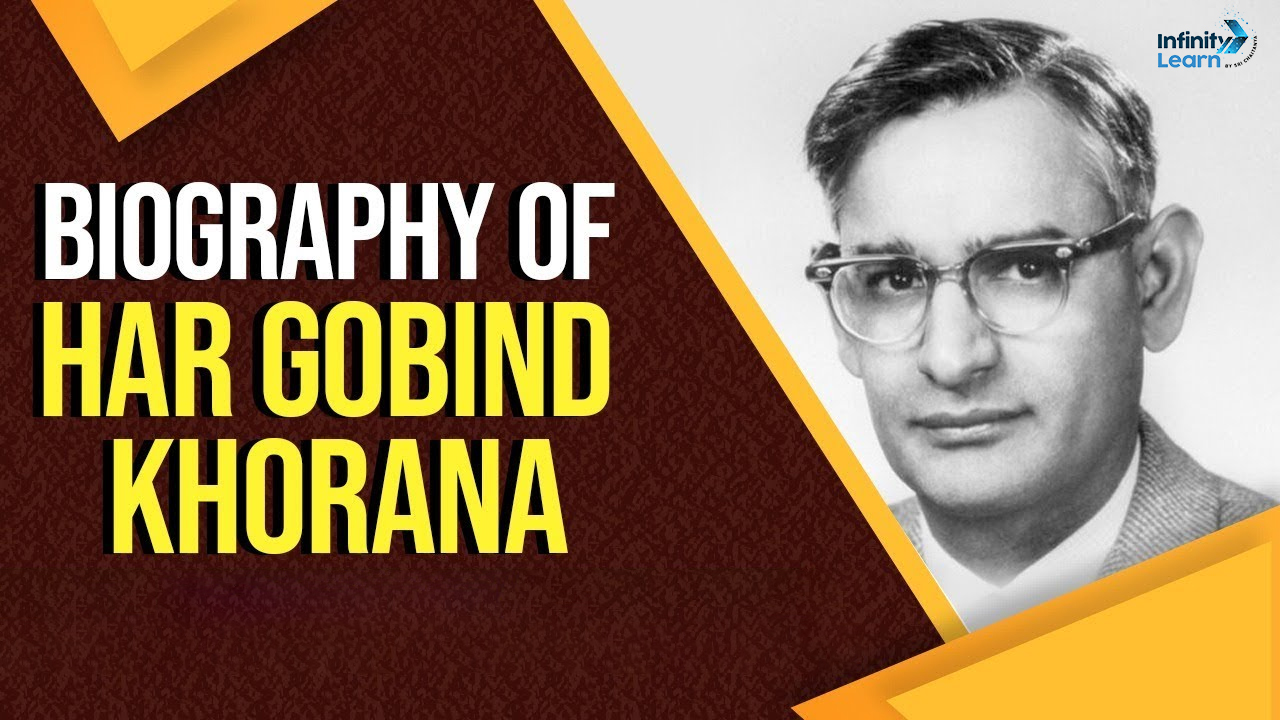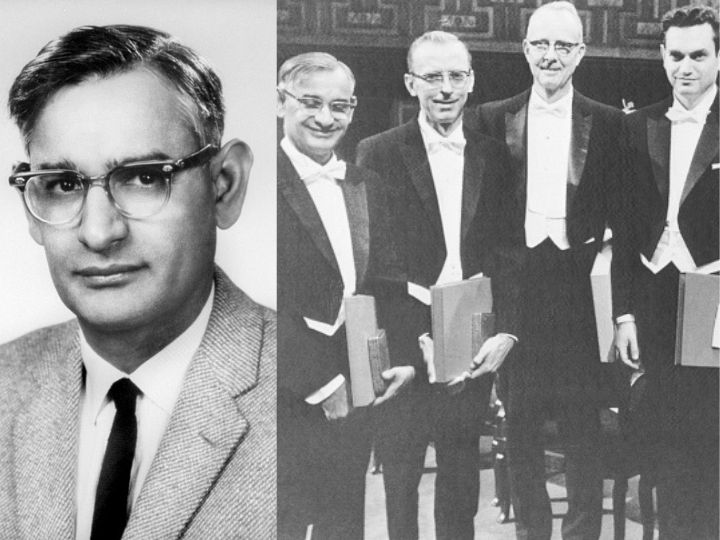Table of Contents
About Har Gobind Khorana
Dr Har Gobind Khorana born in 1922 in Raipur, a small village in Punjab, which is now part of Pakistan. He was born into a Hindu family as the youngest of five children. Although his family was poor, his father was dedicated to educating his children. In fact, Khorana’s family was practically the only literate family in the village of about 100 people.
As a child, Khorana faced challenges due to the family’s poverty. He would wake up early to go around the village looking for a house with smoke coming out of the chimney, and then ask for an ember to take home to light their cooking fire. Khorana also sat on the steps of the nearby post office and transcribed letters for the mostly illiterate townspeople.
Despite the hardships, Khorana’s father helped establish a single-room school in the village and taught Khorana to read at a young age. This early education laid the foundation for Khorana’s remarkable journey from an impoverished village to becoming a Nobel Prize-winning biochemist.
Har Gobind Khorana Education
Dr Har Gobind Khorana attended D.A.V. High School in Multan, where one of his teachers, Ratan Lal, greatly influenced him. He then studied at Punjab University in Lahore, where he obtained a Bachelor’s degree in 1943 and a Master’s degree in Chemistry in 1945.
In 1945, Khorana relocated to England on a Government of India Fellowship to attend the University of Liverpool, where he earned a PhD in Organic Chemistry in 1948 under the supervision of Roger J. S. Beer. He then spent a postdoctoral year in 1948-1949 at ETH Zurich in Switzerland, working with Professor Vladimir Prelog.
After a brief period in India in 1949, Khorana returned to England and obtained a fellowship to work with Dr. G. W. Kenner and Professor A. R. Todd at the University of Cambridge from 1950 to 1952.
Khorana’s educational journey, from a small village in British India to earning advanced degrees in England and Switzerland, laid the foundation for his groundbreaking research in biochemistry and molecular biology.

Har Gobind Khorana Family
Har Gobind Khorana was born in Raipur, Punjab, British India, in 1922 to Ganpat Rai Khorana and Krishna Devi. He was the youngest of five children. Khorana married Esther Elizabeth Sibler and had three children: Julia Elizabeth, Emily Anne, and Dave Roy.
Har Gobind Khorana Discovery
Har Gobind Khorana’s groundbreaking invention was deciphering the genetic code – the universal language of life that provides instructions for building proteins. He discovered that DNA’s four chemical building blocks (A, T, G, C) form a three-letter code, called a codon, that specifies which amino acid goes into a protein. This revolutionary finding unlocked the secrets of how genetic information is stored and used to create the proteins that carry out life’s functions. Khorana’s invention of the genetic code laid the foundation for modern molecular biology and biotechnology.
Har Gobind Khorana Contribution
Dr Har Gobind Khorana, a renowned Indian-American biochemist, made significant contributions to deciphering the genetic code. His work, along with that of Marshall Nirenberg and Robert W. Holley, led to the understanding of how nucleic acids carry the genetic code of the cell and control protein synthesis.
Synthesizing RNA Molecules with Defined Sequences
Khorana developed a method for synthesizing RNA molecules with defined sequences. This was crucial in deciphering the genetic code, as it allowed for the creation of RNA molecules with specific sequences that could be used to study the code.
Deciphering the Genetic Code
Khorana’s alternative decoding technique involved synthesizing RNA with repeating sequences. By creating RNA molecules with constantly repeating building blocks, he was able to decipher a large portion of the genetic code. For example, he synthesized an RNA with repeating AC building blocks, which led to the discovery of the amino acid sequence threonine and histidine.
Har Gobind Khorana Images

Research of Har Gobind Khorana
Dr Har Gobind Khorana’s research was a testament to his pioneering spirit in the field of biochemistry. While he is most renowned for his work on the genetic code and the synthesis of nucleic acids, his contributions extended far beyond these areas.
Deciphering the Genetic Code
Khorana’s most notable achievement was his role in deciphering the genetic code, for which he was awarded the Nobel Prize in Physiology or Medicine in 1968 . His work, along with that of Marshall W. Nirenberg and Robert W. Holley, revealed how the sequence of nucleotides in DNA determines the amino acid sequence of proteins.
Artificial Gene Synthesis
In 1970, Khorana made another groundbreaking contribution to genetics by synthesizing the first artificial copy of a yeast gene. This achievement demonstrated the power of chemical synthesis in understanding the structure and function of genes.
Rhodopsin and Vision
Khorana’s later research focused on the molecular mechanisms underlying cell signaling pathways, particularly in the context of vision. He studied the structure and function of rhodopsin, a light-sensitive protein found in the retina of vertebrates, and investigated mutations associated with retinitis pigmentosa, a condition that causes night blindness.
Chemical Biology and Molecular Biology
Throughout his career, Khorana was a pioneer in the fields of chemical biology and molecular biology. His work on the chemical synthesis of polynucleotides, the building blocks of DNA, laid the foundation for understanding the genetic code. He also made significant contributions to the study of membrane proteins, including the light-driven proton pump bacteriorhodopsin and the visual pigment
Har Gobind Khorana Nobel Prize and Awards
Har Gobind Khorana, an Indian-American biochemist, is best known for his groundbreaking work in deciphering the genetic code and synthesizing the first artificial gene. His most prestigious award was the 1968 Nobel Prize in Physiology or Medicine, which he shared with Marshall W. Nirenberg and Robert W. Holley.
Khorana’s Nobel Prize recognized his research that helped show how the nucleotides in nucleic acids, which carry the genetic code of the cell, control the cell’s synthesis of proteins. He and Nirenberg were also awarded the Louisa Gross Horwitz Prize from Columbia University in the same year.
Throughout his career, Khorana received numerous other honors and awards, including the National Medal of Science in 1987. He was elected as a member of prestigious organizations such as the American Academy of Arts and Sciences, the American Philosophical Society, and the United States National Academy of Sciences.
Har Gobind Khorana Images
Har Gobind Khorana Quotes
Here are some quotes related to Har Gobind Khorana
- I have been extremely lucky in my life in that I have collaborated with brilliant people.
- I have always felt that the amount of money one makes does not reflect the value of the work one does.
FAQs on Har Gobind Khorana
What was Har Gobind Khorana's education?
Har Gobind Khorana's education includes a Bachelor's and Master's degree in chemistry from the University of Punjab, and a PhD in organic chemistry from the University of Liverpool.
What is Har Gobind Khorana known as?
Har Gobind Khorana is known as a luminary in the field of biochemistry and a pioneer in the discovery of the genetic code.
What did Dr. Har Gobind Khorana receive the Nobel Prize for interpreting?
Dr. Har Gobind Khorana received the Nobel Prize in Physiology or Medicine in 1968 for interpreting the genetic code and demonstrating the order of nucleotides in nucleic acids.
What are the works of Khorana?
Khorana's works include the chemical synthesis of the first gene, the synthesis of a related gene, and demonstrating its functionality in a bacterium. He also contributed to the development of PCR tests and studies on rhodopsin.
Who is the father of artificial DNA?
Har Gobind Khorana is considered the father of artificial DNA due to his groundbreaking work in synthesizing the first gene and demonstrating its functionality.
What did Har Gobind Khorana discover?
Har Gobind Khorana discovered the genetic code, demonstrating how nucleotides in nucleic acids determine the synthesis of proteins in cells. He also made significant contributions to the synthesis of artificial genes.








